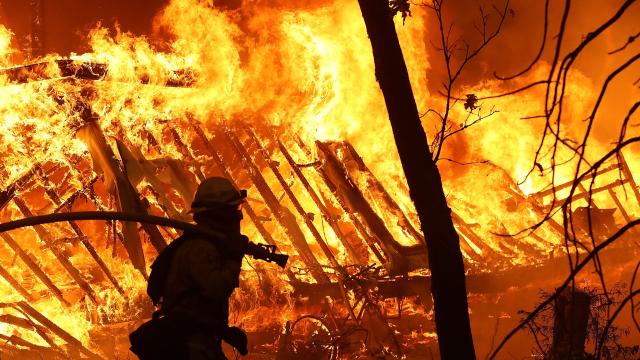Two years later, we’re still adding unfortunate superlatives to the 2018 California wildfire season. The latest is a new study that reveals the hidden toll of what — until this year — was the state’s most destructive fire season.
The findings, published Monday in Nature Sustainability, show that the flames of 2018 roared throughout the U.S. economy, costing the country an estimated $US148.5 ($200) billion in losses. The analysis is a firm reminder that doing nothing about climate change will cripple the economy.
Over the course of 2018, California saw its largest and most destructive fires ever recorded (one of those records has since been blown away by 2020). While the images of entire towns and forests being razed by flames were the most emblematic images of the 2018 wildfire season, the state suffered under a haze of smoke. The Cal-Stanford football game dubbed “the Big Game” was cancelled; games that did go on saw players sucking oxygen on the sidelines; and the world got a prescient glimpse of life in n95 masks as California choked on the most toxic air on the planet. The plume of smoke eventually stretched across the U.S.
The new paper takes a meta view of all this suffering and loss and tallies it up in dollars and cents. While the Camp Fire, which destroyed nearly the entire town of Paradise, was the most costly direct loss, the new findings show the hidden toll of the wildfires that raged across the state. The researchers calculated not just the loss of buildings and lives; they also pulled together air quality data and measured its impact on health and looked at 80 industries that were impacted by wildfires.
The results show that at the peak of the Camp Fire in November, nearly 40% of the state’s population was breathing air deemed unhealthy or worse. But at other parts of the year, large portions of the state were also dealing with an unhealthy amount of wildfire smoke-related air pollution. Estimating the impact on mortality, the researchers found that there were 3,652 air pollution-related deaths. “Applying the value of statistical life,” the researchers wrote, that equals a $US32.2 ($43) billion loss alone.
But by far the biggest costs are tied to indirect economic losses. Whether its work slow downs, supply chain disruptions, loss of agricultural productivity, construction projects shelved, or other impacts, the new study estimates the 2018 wildfire season cost a stunning $US88.6 ($119) billion. Within the state, the Sacramento County suffered the greatest losses, despite no fires igniting there. And the losses extend well beyond state borders; $US45.9 ($62) billion of the $US88.6 ($119) billion was spread across the U.S.
Absent the dollar sign, the human toll is absolutely horrifying to consider. The air pollution deaths are greater than the sum of those lost on September 11. But when factoring all the economic losses, it also becomes clear that climate change isn’t a blue state or red state problem. It’s an everywhere problem, since impacts ripple throughout the entire economy. Smoke, supply chains, and the loss of human life do not respect borders.
But more than anything, the findings show that the argument for doing nothing about climate change because it costs too much or asking bUt HoW wIlL wE pAy FoR iT are simply bunk.
“We talk a lot in policy about the costs of a policy (e.g., the $US2 ($3) trillion Biden plan and all that) but we rarely ever frame these costs as bringing benefits,” Amir Jina, a climate economist at the University of Chicago, said in an email. “There’s a return on that $US2 ($3) trillion investment that we never ever talk about, and this makes it hard to make climate policy gain traction with people. The broader purpose of studies like this gives us an opportunity to understand that there are benefits to climate policy in terms of our wallets, but also our health and well-being.”
We’re already paying for all the carbon pollution the world has emitted since the Industrial Revolution. Rising temperatures have made forests more combustible. Wildfire season is now 105 days longer than it used to be. The 2018 wildfire season was just a harbinger of the 2020 wildfire season, which smashed numerous records. And both are warnings of what will come if we do nothing — and the costs will be astronomical.
